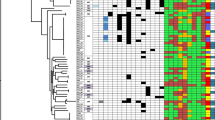Summary
Mechanisms of resistance to five aminoglycoside antibiotics: gentamicin (G), tobramycin (T), netilmicin (N), amikacin (A) and isepamicin (I), were assessed in 16 clinical isolates ofPseudomonas aeruginosa serotype O11, originating from five hospitals in Bratislava. All isolates werein vitro highly resistant to all mentioned aminoglycoside antibiotics (MIC>32 mg/l). Thirteen isolates produced three aminoglycoside-modifying enzymes (AGME), responsible for resistance to the respective aminoglycosides: AAC(6′)-I (T, N, A); APH (2″) (G, T); APH (3′)-VI (I). In addition to this, in four isolates a production of AAC(3)-II (G, T, N) was observed. In three isolates no production of AGME was observed. The strains studied were isolated mainly from urine. Several isolates were able to transfer aminoglycoside resistance by bacterial conjugation toP. aeruginosa 1008 rifr recipient. The transconjugants from these transfers expressed the same resistance pattern and nearly the same mechanisms of resistance as the donor strains.
Zusammenfassung
Bei 16 klinischen Isolaten vonPseudomonas aeruginosa Serotyp O11 aus fünf Krankenhäusern in Bratislava wurde der Mechanismus der Resistenz gegen fünf Aminoglykosid-Antibiotika untersucht; Gentamicin (G), Tobramycin (T), Netilmicin (N), Amikacin (A) und Isepamicin (I). Alle Isolate warenin vitro hochresistent gegen alle genannten Aminoglykosid-Antibiotika (MHK-Werte >32 mg/l). 13 der Isolate bildeten drei Aminoglykosid-modifizierende Enzyme (AGME), die für die Resistenz gegenüber den entsprechenden Aminoglykosiden verantwortlich waren: AAC(6′)-I (TNA): APH (2″) (G, T): APH (3′)-VI (I). Zusätzlich wurde bei drei Isolaten die Produktion von AAC(3)-II (G, T. N) beobachtet. In drei Isolaten fand sich keine Produktion von AGME. Die untersuchten Stämme waren überwiegend aus Urin isoliert worden. Mehrere der Isolate waren fähig, die Aminoglykosid-Resistenz durch bakterielle Konjugation auf denP. aeruginosa 1008 rifr Rezipienten zu übertragen. Die Transkonjugate von diesen Übertragungen exprimierten dasselbe Resistenzmuster und wiesen nahezu denselben Resistenzmechanismus auf wie die Spenderstämme.
Similar content being viewed by others
References
Korvick, J. A., Yu, V. L. Antimicrobial agent therapy forPseudomonas aeruginosa. Antimicrob. Agents Chemother. 35 (1991) 2167–2172.
Champion, H. M., Bennett, P. M., Lewis, D. A., Reeves, D. S. Cloning and characterization of AAC(6′) gene fromSerratia marcescens. J. Antimicrob. Chemother. 22 (1988) 587–596.
Brokopp, C. D., Gómez-Lus, R., Farmer, J. J. Serological typing ofPseudomonas aeruginosa: use of commercial antisera and live antigens. J. Clin. Microbiol. 11 (1977) 640–649.
Bauer, A. W., Kirby, W. M., Sherris, J. C., Turck, M. Antibiotic susceptibility testing by a standardized single disk method. Am. J. Clin. Pathol. 45 (1966) 493–496.
Ericsson, H. M., Sherris, J. C. Antibiotic sensitivity testing: report of an international collaborative study. Acta Path. Microbiol. Scand. B 217 (1971) 65–73.
Kettner, M., Navarová, J., Rýdl, Z., Knothe, H., Lebek, G., Krčméry, V. Occurrence of aminoglycoside-modifying enzymes in resistant strains of enterobacteria andPseudomonas aeruginosa from several countries. J. Antimicrob. Chemother. 8 (1981) 175–185.
Shaw, K. J., Rather, P. N., Hare, R. S., Miller, G. H. Molecular genetics of aminoglycoside resistance genes and familiar relationships of the aminoglycoside-modifying enzymes. Microbiol. Rev. 57 (1993) 138–163.
Sader, H. S., Pignatari, A. C., Leme, I. L., Burattini, M. L., Tancresi, R., Hollis, R. J., Jones, R. N. Epidemiologic typing of multiply drug-resistantPseudomonas aeruginosa isolated from an outbreak in an intensive care unit. Diagn. Microbiol. Infect. Dis 17 (1993) 13–18.
Kettner, M., Adam, D., Mačičková, T., Braveny, I., Milošovič, P. Mechanisms of resistance to aminoglycosides in amikacin-resistant gram-negative bacteria. Zeitschr. Antimikrob. Antineopl. Chemother. 11 (1993) 51–55.
Farmer III, J. J., Weinstein, R. A., Zierdt, C. H., Brokopp, C. D. Hospital outbreaks caused byPseudomonas aeruginosa: importance of serogroup O11. J. Clin. Microbiol. 16 (1982) 266–270.
Watine, J., Bourrel, C., Dubourdieu, B., Ginsten, J. L., Bories, P., Durand, M., Marre, A., Formosa, F., Brunel, M. P., Palliez, J. Susceptibility of multiresistant serotype O12Pseudomonas aeruginosa to fosfomycin in combination with other antibiotics. Path. Biol. 42 (1994) 293–295.
Žatkovič, B., Trupl, J., Majtán, V. Survey of susceptibility to selected antibiotics ofPseudomonas aeruginosa strains isolated from patients with tumor disease and their relationship to serotype. Folia Microbiol. 38 (1993) 415–420.
Van Hoof, R., Godard, C., Nulens, E., Nyssen, H. J., Wildemauwe, C., Hubrechts, J. M., Maes, P., Hannecart-Pokorni, E. Serotypes and extended spectrum beta-lactam resistance in aminoglycoside resistantPseudomonas aeruginosa isolates from two Belgian general hospitals: a seven year study. J. Hosp. Inf. 24 (1993) 129–138.
Kallová, J., Mačičková, T., Majtánová, A., Ághová, A., Adam, D., Kettner, M.: Transferable amikacin resistance in gram-negative bacterial isolates. Chemotherapy (in press).
Shaw, K. J., Wu, S., Kettner, M., Hare, R. S., Miller, G. H.: Isolation, characterization and DNA sequence analysis of a novel aminoglycoside-modifying enzyme fromEscherichia coli. 33rd ICAAC, New Orleans, 1993, abstr. 206.
Author information
Authors and Affiliations
Rights and permissions
About this article
Cite this article
Kettner, M., Kallová, J., Hletková, M. et al. Incidence and mechanisms of aminoglycoside resistance inPseudomonas aeruginosa serotype O11 isolates. Infection 23, 380–383 (1995). https://doi.org/10.1007/BF01713571
Received:
Accepted:
Issue Date:
DOI: https://doi.org/10.1007/BF01713571




